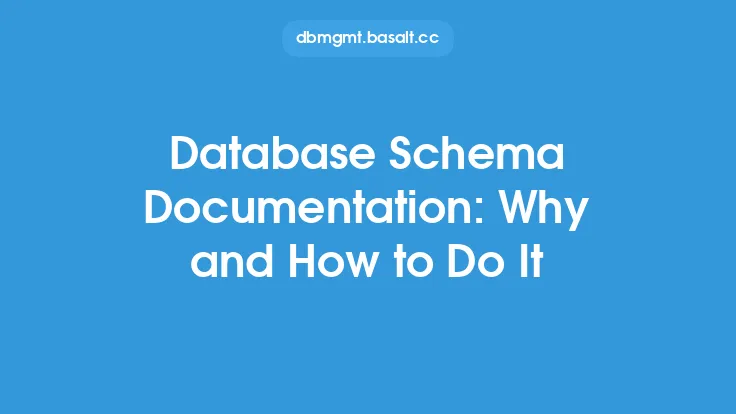Database fragmentation is a common issue that can significantly impact the performance and efficiency of a database. It occurs when free space is created in a database due to the deletion or modification of data, causing the database to become fragmented. This can lead to slower query performance, increased disk space usage, and reduced overall database reliability. In this article, we will delve into the world of database fragmentation, exploring its causes, effects, and most importantly, how to resolve it.
What is Database Fragmentation?
Database fragmentation refers to the condition where a database's storage space is broken into small, non-contiguous chunks, making it difficult for the database to efficiently store and retrieve data. This can happen due to various reasons, including data insertion, deletion, and modification. When data is deleted or modified, the space occupied by that data becomes free, but it may not be contiguous with other free space, leading to fragmentation. Additionally, database fragmentation can also occur due to the growth of indexes, which can lead to page splits and fragmentation.
Causes of Database Fragmentation
There are several causes of database fragmentation, including:
- Frequent data insertion, deletion, and modification: These operations can cause fragmentation by creating free space that is not contiguous with other free space.
- Index growth: As indexes grow, they can become fragmented, leading to page splits and reduced query performance.
- Poor database design: A poorly designed database can lead to fragmentation by causing data to be stored in a non-contiguous manner.
- Lack of maintenance: Failing to regularly maintain a database can lead to fragmentation, as free space is not reclaimed and indexes are not rebuilt.
Effects of Database Fragmentation
Database fragmentation can have several negative effects on a database, including:
- Reduced query performance: Fragmentation can cause queries to take longer to execute, as the database has to search for data in multiple locations.
- Increased disk space usage: Fragmentation can cause a database to use more disk space than necessary, as free space is not reclaimed.
- Reduced database reliability: Fragmentation can lead to database corruption and instability, as the database becomes more prone to errors and crashes.
Identifying Database Fragmentation
Identifying database fragmentation can be done using various tools and techniques, including:
- Database management system (DBMS) built-in tools: Most DBMSs have built-in tools that can help identify fragmentation, such as the `dbcc showcontig` command in Microsoft SQL Server.
- Third-party tools: There are several third-party tools available that can help identify fragmentation, such as database monitoring and analysis tools.
- Query performance analysis: Analyzing query performance can help identify fragmentation, as queries that take longer to execute may be affected by fragmentation.
Resolving Database Fragmentation
Resolving database fragmentation involves reorganizing the database's storage space to eliminate fragmentation. This can be done using various techniques, including:
- Rebuilding indexes: Rebuilding indexes can help eliminate fragmentation by reorganizing the index pages and reducing page splits.
- Reorganizing data: Reorganizing data can help eliminate fragmentation by reorganizing the data pages and reducing free space.
- Defragmenting disk space: Defragmenting disk space can help eliminate fragmentation by reorganizing the free space and reducing disk space usage.
- Using DBMS built-in tools: Most DBMSs have built-in tools that can help resolve fragmentation, such as the `dbcc indexdefrag` command in Microsoft SQL Server.
Preventing Database Fragmentation
Preventing database fragmentation involves taking proactive steps to reduce the likelihood of fragmentation occurring. This can be done using various techniques, including:
- Regularly maintaining the database: Regularly maintaining the database can help prevent fragmentation by reclaiming free space and rebuilding indexes.
- Implementing a good database design: Implementing a good database design can help prevent fragmentation by storing data in a contiguous manner.
- Monitoring query performance: Monitoring query performance can help identify potential fragmentation issues before they become major problems.
- Using automatic maintenance tools: Using automatic maintenance tools can help prevent fragmentation by automatically rebuilding indexes and reorganizing data.
Best Practices for Database Fragmentation
Best practices for database fragmentation include:
- Regularly monitoring database fragmentation: Regularly monitoring database fragmentation can help identify potential issues before they become major problems.
- Implementing a regular maintenance schedule: Implementing a regular maintenance schedule can help prevent fragmentation by reclaiming free space and rebuilding indexes.
- Using DBMS built-in tools: Using DBMS built-in tools can help resolve fragmentation and prevent future fragmentation issues.
- Implementing a good database design: Implementing a good database design can help prevent fragmentation by storing data in a contiguous manner.
- Testing and validating database changes: Testing and validating database changes can help prevent fragmentation by identifying potential issues before they become major problems.
Conclusion
Database fragmentation is a common issue that can significantly impact the performance and efficiency of a database. By understanding the causes, effects, and resolution techniques of database fragmentation, database administrators can take proactive steps to prevent and resolve fragmentation issues. Regular maintenance, good database design, and monitoring query performance are all essential for preventing database fragmentation. By following best practices and using DBMS built-in tools, database administrators can help ensure that their databases remain efficient, reliable, and performant.





